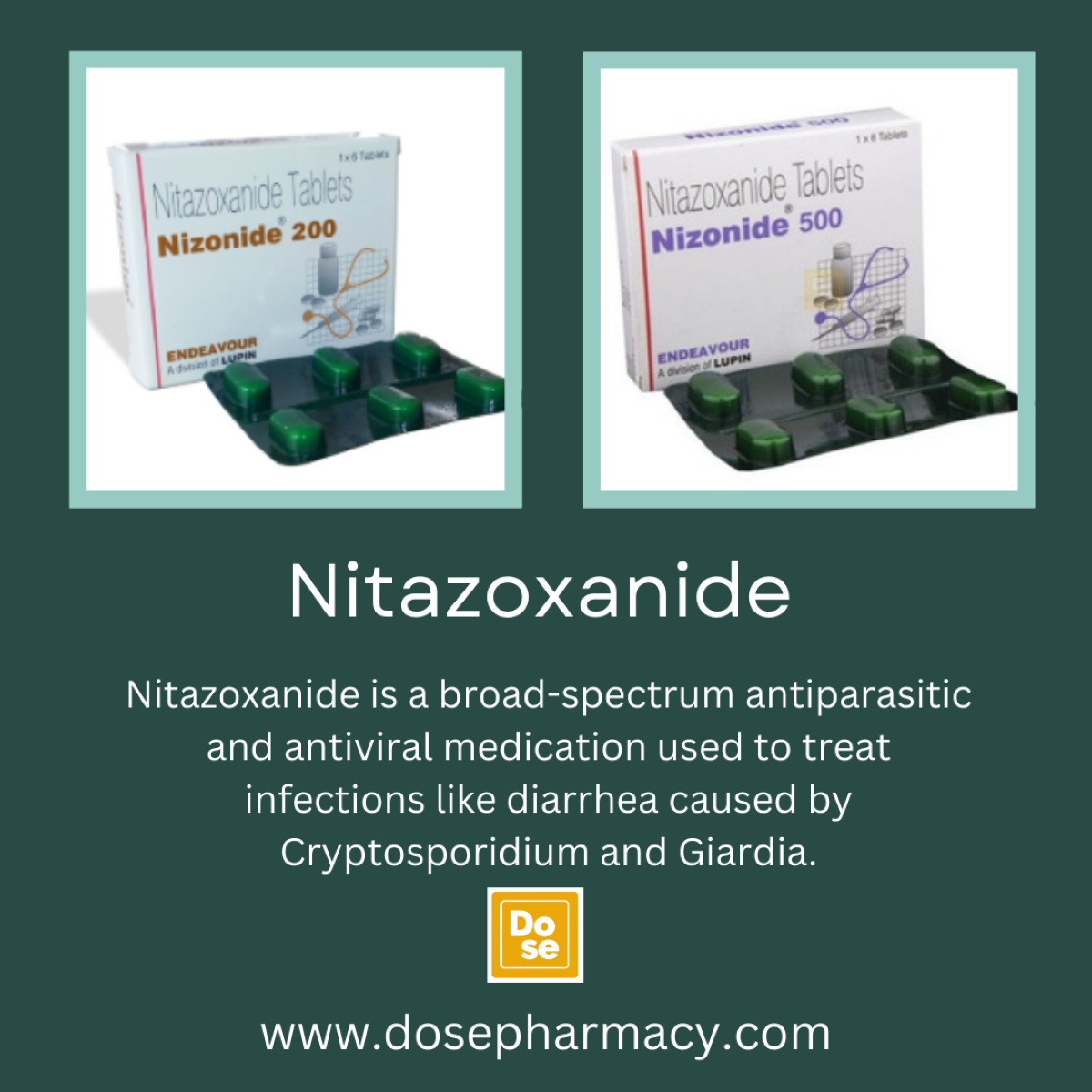Nitazoxanide for Diarrhea and Parasitic Infections: Does It Work?

Diarrhea and parasitic infections are common health issues worldwide, particularly in regions with poor sanitation or limited access to clean water. These conditions not only cause discomfort but can also lead to serious complications if untreated, especially in children, older adults, or those with weakened immune systems. One medication that has gained attention for treating such infections is Nitazoxanide 500 mg. But how effective is it really, and how does it work? Let’s break it down.
What Is Nitazoxanide?
Nitazoxanide is a broad-spectrum antiparasitic and antiviral medication. It belongs to the thiazolide class of drugs and was first approved in the United States in 2002. Unlike many older antiparasitic drugs that target only one type of organism, nitazoxanide is known for its wide range of activity. It has been shown to be effective against protozoa, helminths (worms), and even some viruses.
It is most commonly prescribed to treat diarrhea caused by protozoal infections, such as:
- Giardia lamblia (giardiasis)
- Cryptosporidium parvum (cryptosporidiosis)
Both of these parasites are leading causes of watery diarrhea, especially in children and people living with HIV/AIDS.
How Does Nitazoxanide Work?
Nitazoxanide interferes with the energy metabolism of parasites. Specifically, it blocks an enzyme called pyruvate:ferredoxin oxidoreductase (PFOR), which is crucial for anaerobic energy production in many protozoa and helminths. Without this enzyme, the parasite cannot generate the energy it needs to survive, eventually leading to its death.
Interestingly, nitazoxanide also shows antiviral activity. Research suggests that it interferes with the replication of certain viruses, including rotavirus, influenza, and hepatitis viruses, although it is not officially approved for these uses.
Nitazoxanide for Diarrhea
1. Diarrhea Caused by Giardia
Giardiasis is a common intestinal infection transmitted through contaminated food or water. Symptoms include watery diarrhea, abdominal cramps, gas, and bloating. Clinical studies have shown that nitazoxanide effectively clears giardia infections, often within 3 days of treatment.
2. Diarrhea Caused by Cryptosporidium
Cryptosporidiosis is another major cause of persistent diarrhea, especially in young children and immunocompromised patients. Unlike many other drugs, nitazoxanide has proven effectiveness against Cryptosporidium, which makes it an important treatment option.
3. Viral Diarrhea
There is growing evidence that nitazoxanide may also reduce the duration of viral gastroenteritis caused by rotavirus and norovirus. Although it is not officially approved for this use, research suggests it could shorten the length of illness in children.
Nitazoxanide for Parasitic Infections
Beyond diarrhea, nitazoxanide has been studied for other parasitic infections:
- Helminths (worms): It has shown some activity against roundworms, hookworms, and tapeworms, although it is not the first-line treatment for these conditions.
- Amebiasis: Caused by Entamoeba histolytica, nitazoxanide has demonstrated moderate success in treating this infection.
- Other protozoa: It has been tested against Blastocystis hominis, a parasite that can cause chronic diarrhea, with promising results.
Because of its broad action, nitazoxanide is sometimes considered a “universal” antiparasitic, though its strongest evidence is still for giardiasis and cryptosporidiosis.
How Effective Is Nitazoxanide?
Effectiveness depends on the infection being treated:
- Giardiasis: Cure rates are generally above 80–90% with a standard 3-day course.
- Cryptosporidiosis: Effective in both children and adults, though immunocompromised patients may require longer treatment.
- Other parasitic infections: Results vary, but many studies suggest that nitazoxanide is a useful option when other drugs fail or are not available.
- Viral infections: More research is needed, but clinical trials show potential for reducing the severity and duration of viral diarrhea.
Dosage and Administration
The dosage depends on age and condition:
- Adults and children over 12 years: 500 mg orally, every 12 hours for 3 days.
- Children 4–11 years: 200 mg orally, every 12 hours for 3 days.
- Children 1–3 years: 100 mg orally, every 12 hours for 3 days.
Nitazoxanide should be taken with food, as this improves absorption. Skipping doses or stopping early can reduce its effectiveness.
Side Effects and Safety
Most people tolerate nitazoxanide well. Common side effects include:
- Stomach pain
- Headache
- Nausea
- Vomiting
- Yellowish discoloration of the eyes or urine (harmless and temporary)
Serious side effects are rare. However, patients with liver disease, kidney disease, or weakened immunity should consult their doctor before taking nitazoxanide. Pregnant and breastfeeding women should only use it if clearly prescribed.
Who Should Avoid Nitazoxanide?
- People allergic to nitazoxanide or its ingredients.
- Individuals with severe liver or kidney conditions (unless approved by a doctor).
- Infants younger than 12 months.
Advantages of Nitazoxanide
- Broad spectrum – works against multiple parasites and even some viruses.
- Short treatment course – typically only 3 days.
- Good safety profile – mild and temporary side effects.
- Effective in children – one of the few antiparasitic drugs safe for young children.
Limitations of Nitazoxanide
- Not always effective in severely immunocompromised patients (e.g., advanced HIV/AIDS).
- More research is needed to confirm its role in viral infections.
- May not work as well for parasitic worms compared to specialized anti-worm drugs like mebendazole or albendazole.
Nitazoxanide is a valuable treatment for diarrhea caused by protozoal infections, especially giardiasis and cryptosporidiosis. Its short treatment course, broad spectrum of activity, and safety profile make it a convenient option for both children and adults. While its role in treating viral diarrhea and other parasitic infections is still being studied, the results are promising.
If you or your child experiences persistent diarrhea, especially after possible exposure to contaminated food or water, a doctor may consider nitazoxanide as part of treatment. As with any medication, it should only be used under medical guidance to ensure safety and effectiveness.




